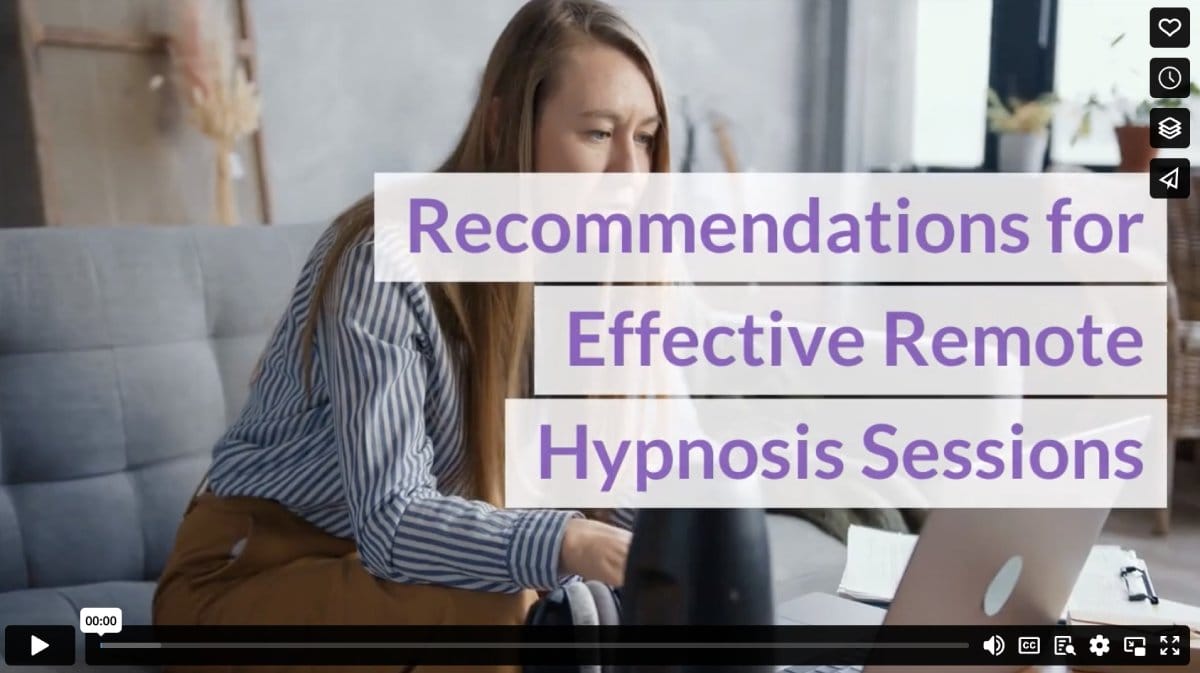In our post-Covid-lockdown world, it seems everything has gone virtual. You can complete your shopping, chat with friends, have a doctor’s appointment, and sometimes even do your job without ever leaving home. The upside to this is that more activities and experiences are accessible to everyone. The downside is a potential lack of connections.
Hypnosis has also gone virtual. Remote hypnosis sessions see the same benefits and downsides that remote communication brings to other uses. No matter a person’s location, they can experience relief and assistance with their traumas and challenges that come from hypnosis. However, the experience of sitting in front of a computer screen is far less immersive than being in someone’s office.
Fortunately, that doesn’t need to affect the quality of the care and wellness you provide to your clients. We have recommendations to help ensure the clients you see remotely achieve the same results as those with an in-person experience.
Background Information
Your path to remote-session success starts long before your first virtual appointment. Look at your setup. Your background matters.
It will be challenging for your client to feel relaxed if they see chaos behind you. Create a clutter-free, serene environment as your background. People feel stressed out looking at their mountain of laundry that needs folding. They don’t want to look at yours, either.
A blank wall feels cold and sterile. A stripped-down background won’t create the relaxed environment you want to foster. The other end of that extreme isn’t ideal, either: too much stuff is too much. You want a scene that feels comforting and welcoming. You don’t want your client focusing on the titles of the books behind you or trying to figure out if that’s a Beanie Baby collection displayed over your left shoulder. Don’t create a background that pulls attention away from the business at hand: hypnosis. Your client should focus on you and your voice, not your coveted Princess Diana Beanie Baby.
Tech Check
You’re a professional hypnotist, not an IT guru. But you still need to master the technology. A reliable internet connection is vital. It will be nearly impossible to help a client reach a hypnotic state if your induction is fraught with glitches and tech-based stutters. The last thing you want is a mid-trance frozen screen.
Familiarize yourself with the software you intend to use. Do several practice runs with a friend or family member. That will ensure you understand what to do to start the session. Ask your test subjects to explain how they experienced the sign-on and relay those instructions to your clients. You want to avoid technology concerns creating additional stress for your clients before their sessions even begin.
Plan B
No matter how well you prep your tech, glitches happen. Have a plan B in place. Communicate that plan to your remote clients. They should know that they can contact you if they cannot connect or the call drops.
Consider having a backup device. You’ll want to be able to quickly pivot to your computer if your phone battery dies or your tablet powers down. You may even have an alternative software option. If your chosen platform is offline, your client will know to try the backup.
Mic Drop
Invest in a quality microphone. Many inexpensive options are available, nearly all of which provide better audio quality than the mics built into your computer or phone. You’ve worked hard to cultivate a soothing, hypnotic voice. Don’t lose the power of that due to a microphone that makes you sound muffled or difficult to understand.
Finding your Place
Consider the placement of your computer or phone. Test your setup ahead of time and see what the client’s view is. You may need to elevate your camera by placing your device on a box or stack of books.
Look at the lighting. Adjust it if there are distracting shadows or the sun shines directly into your eyes. Investing in a ring light to sit behind your camera will provide a pleasing, soft light. This diffused lighting can help create a soothing, serene environment ideal for hypnosis sessions. You don’t need to treat this like a modeling audition where you find the absolute best light and most flattering angles. But you should settle on a setup that works for you and isn’t distracting for the client.
Eye Eye, sir!
Your classes may have emphasized the importance of eye contact. That becomes even more vital, as well as more challenging, with remote hypnosis sessions.
Train your gaze directly on the camera, not on the client’s image on the screen. It feels natural to look at the person you are speaking to, even when that’s an image on a screen. However, if you do that, the person on the other side of the connection experiences it as though you aren’t looking at them. Your focus should be on the camera. That’s the gateway to really connecting with your client.
If you are distracted by the box showing your image, minimize or turn off that feature.
Comfort Level
In your office, you provide a comfortable chair for your client. You can have tissues on hand in case the conversation gets emotional or water in case of dry mouth. In a remote setting, you can’t provide any of those things. Consider creating a set of suggestions for your clients. Provide it to them before their first session, and continue to remind them before subsequent meetings.
Advise them to create a comfortable place for themselves. They may want a blanket, water, tissues, or anything else to help them feel comfortable.
Remind them to set aside a quiet space and time for their session. There’s no risk of someone’s child bursting in for homework help when they are in your office. They will feel your office is private and secure. The more they can recreate that environment in their own space, the better they can relax and attain a hypnotic state.
The remote-session instructions you send before the meeting will encourage them to set the stage for a successful session.
Pause-itively Critical
With in-person speech, we pick up on subconscious clues about when it is our turn to speak. That can be more challenging in virtual environments. On top of that, there is a slight delay while our image and audio are sent or received. That can lead to both parties talking over one another.
Make a habit of taking just a moment to pause before speaking. That will ensure your client has finished their thought before you continue.
There you have it. Navigating the world of remote hypnosis sessions relies mainly on the skills you’ve learned during your hypnotherapy program. However, online communication requires a few extra considerations to make it conducive to hypnosis sessions. May your internet be strong, your mic clear, and your clients’ lives transformed by their remote hypnosis sessions.
Video

Infographic
Remote hypnosis sessions can be as effective as in-person ones, offering relief and support for various challenges despite the less immersive experience of a computer screen. Explore helpful tips to ensure remote clients achieve the same results as those with an in-person experience in this infographic.




